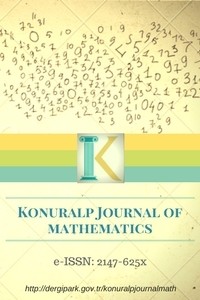Higher Order Real Derivatives Using Parabolic Analytic Functions
Higher Order Real Derivatives Using Parabolic Analytic Functions
Parabolic, Analytic functions, Dual number, Higher order derivative automatic differentiation, Hypercomplex numbers.,
___
- [1] Bischof, C.H., Pusch, G.O., Knoesel, R.: Sensitivity analysis of the mm5 weather model using automatic differentiation. Computers in Physics 10(6), 605–612 (1996)
- [2] Bisi, C., De Martino, A., Winkelmann, J.: On a runge theorem over R3. Annali di Matematica 202(4), 1531–1556 (2023)
- [3] Bisi, C., Winkelmann, J.: On a quaternionic Picard theorem. Proc. Amer. Math. Soc., Ser. B, 7, 106–117 (2020)
- [4] Bisi, C., Winkelmann, J.: The harmonicity of slice regular functions. The Journal of Geometric Analysis 31(8), 7773–7811 (2021)
- [5] Casanova, G.: Parabolic analytic functions. Adv. Appl. Clifford Algebras 9(2), 221–224 (1999)
- [6] Catoni, F., Cannata, R., Catoni, V., Zampetti, P.: N-dimensional geometries generated by hypercomplex numbers. Adv. Appl. Clifford Algebr. 15(1), 1–25 (2005)
- [7] Catoni, F., Cannata, R., Nichelatti, E.: The parabolic analytic functions and the derivative of real functions. Adv. Appl. Clifford Algebr. 14(2), 185–190 (2004)
- [8] Fjelstad, P., Gal, S.G.: Two-dimensional geometries, topologies, trigonometries and physics generated by complex-type numbers. Adv. Appl. Clifford Algebras 11(1), 81–107 (2001)
- [9] Gentili, G., Stoppato, C., Struppa, D.: Regular Functions of a Quaternionic Variable. Springer Monographs in Mathematics. Springer (2022)
- [10] Hovland, P.D., et al: Sensitivity analysis and design optimization through automatic differentiation. J. Phys.: Conf. Ser. 16, 466–470 (2005)
- [11] Kedem, G.: Automatic differentiation of computer programs. ACM Trans. Math. Software 6(2), 150–165 (1980)
- [12] Mehmood, S., Ochs, P.: Automatic differentiation of some first-order methods in parametric optimization. In: Proceedings of the Twenty Third International Conference on Artificial Intelligence and Statistics, vol. 108, pp. 1584–1594. PMLR (2020)
- [13] Pe˜nu nuri, F., Pe´on, R., Gonz´alez-S´anchez, D., Escalante Soberanis, M.A.: Dual numbers and automatic differentiation to efficiently compute velocities and accelerations. Acta Appl. Math. 170, 649–659 (2020)
- [14] Press, W.H., Teukolsky, S.A., Vetterling, W.T., Flannery, B.P.: Numerical recipes in Fortran 77: The art of scientific computing. Cambridge University Press (1992)
- [15] Versteeg, H.K., Malalasekera, W.: An Introduction to Computational Fluid Dynamics: The Finite Volume Method. Pearson Education (2007)
- [16] Yaglom, I.M.: A simple non-Euclidean geometry and its physical basis. Heidelberg Science Library. Springer-Verlag, New York-Heidelberg (1979). An elementary account of Galilean geometry and the Galilean principle of relativity, Translated from the Russian by Abe Shenitzer, With the editorial assistance of Basil Gordon.
- Yayın Aralığı: Yılda 2 Sayı
- Başlangıç: 2013
- Yayıncı: Mehmet Zeki SARIKAYA
Quantum Difference Problem with Point Interaction
Yelda AYGARKÜÇÜKEVCİLİOĞLU, Güher Gülçehre ÖZBEY, Güler Başak ÖZNUR
Hardy Type Inequalities for Convex Functions
Higher Order Real Derivatives Using Parabolic Analytic Functions
Finding Powerful Solutions for the Generalized Hyperelastic-Rod Wave Equation
Şeyma TÜLÜCE DEMİRAY, Uğur BAYRAKCI
Diffusion Equation Including Local Fractional Derivative and Dirichlet Boundary Conditions
Weakly Prime Radical of Submodules
On the Construction of the Surface Family with a Common Involute Geodesic
Spectrum and Fine Spectrum of the Triple Repetitive Double-Band Matrix Over the Sequence Space $cs$
